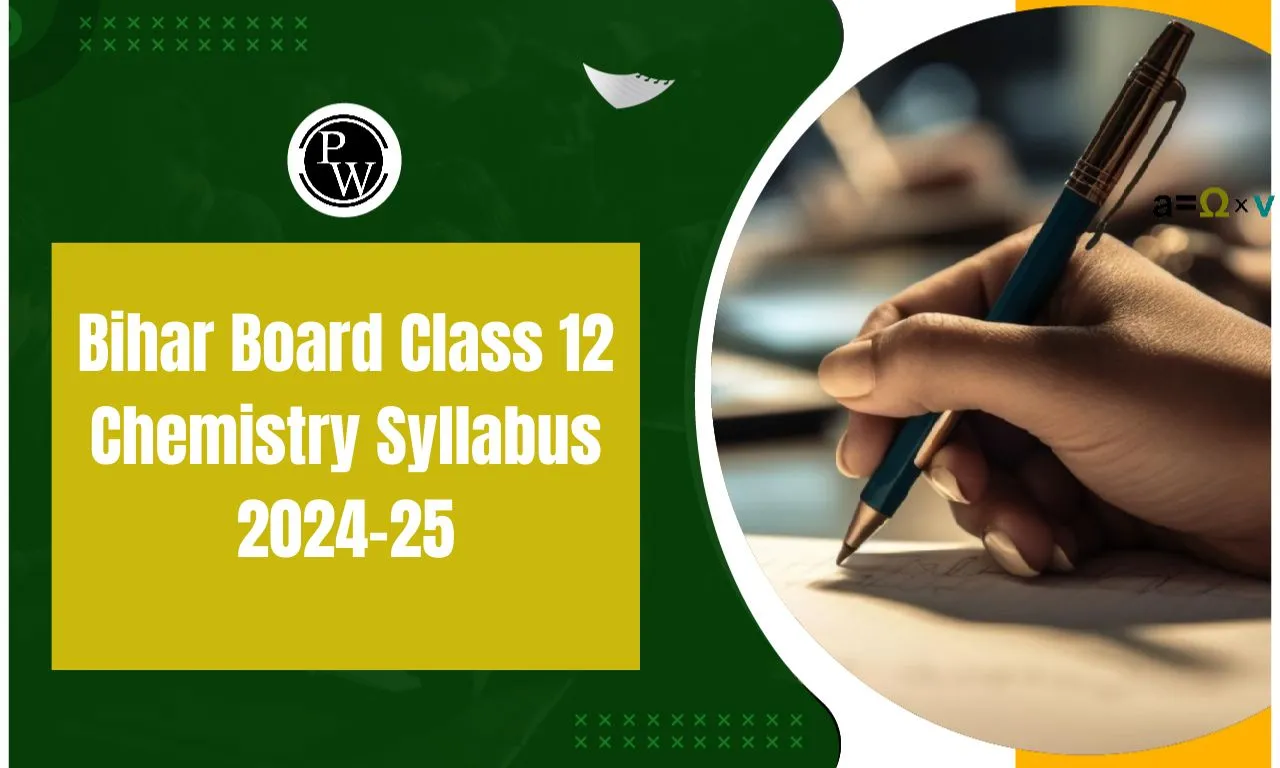
Bihar Board Class 12 Chemistry Syllabus 2024-25: The Bihar Board Class 12 Chemistry syllabus for 2024-25 covers key topics across Physical, Organic, and Inorganic Chemistry. In Physical Chemistry, topics like solutions, electrochemistry, chemical kinetics, and surface chemistry are included.
Organic Chemistry covers haloalkanes, haloarenes, alcohols, phenols, ethers, and biomolecules. Inorganic Chemistry focuses on the periodic table, coordination compounds, and p-block elements. Practical experiments play a vital role, in enhancing conceptual understanding through laboratory work, including salt analysis, titration, and preparation of organic compounds. Here we have provided Bihar Board Class 12 Chemistry Syllabus 2024-25 in detail.
Below we have provided an overview of the Bihar Board Class 12 Chemistry Syllabus 2024-25 i
|
Bihar Board Class 12 Chemistry Syllabus 2024-25 Overview |
|
| Authority | Bihar School Examination Board (BSEB) |
| Class | 12th |
| Subject | Chemistry |
| Syllabus | Class 12th Chemistry syllabus |
| Official website | biharboardonline.com |
Bihar Board Class 12 Chemistry Syllabus PDF Download
Visit the Official Website : Go to the official website of the Bihar School Examination Board (BSEB) at biharboardonline.bihar.gov.in .
Navigate to the 'Syllabus' Section : On the homepage, look for the "Syllabus" or "Downloads" section, usually available in the main menu or under the "Student Section" category.
Select Class and Subject : In the syllabus section, choose the Class 12 option and then select the subject as "Chemistry."
Download the Syllabus : Click on the link provided for the Chemistry syllabus. The syllabus will open as a PDF file. You can then download it or save it for future reference.
Print (Optional) : If you prefer a hard copy, you can print the downloaded PDF document.
To perform well in Chemistry in Class 12, students must familiarize themselves with the BSEB Class 12 syllabus 2024. Practicing with the latest Bihar Board model papers for class 12 and referring to previous years’ question papers can significantly aid preparation. Below is the Bihar Board Class 12 Chemistry Syllabus:
|
Bihar Board Class 12 Chemistry Syllabus 2024-25 |
|
|---|---|
| Serial Number | Chapter |
| 1. | The Solid State |
| 2. | Solutions |
| 3. | Electrochemistry |
| 4. | Chemical Kinetics |
| 5. | Surface Chemistry |
| 6. | General Principles and Processes of Isolation of Elements |
| 7. | The p-Block Elements |
| 8. | The d-and f-Block Elements |
| 9. | Coordination Compounds |
| 10. | Haloalkanes and Haloarenes |
| 11. | Alcohols, Phenols, and Ethers |
| 12. | Aldehydes, Ketones, and Carboxylic Acids |
| 13. | Amines |
| 14. | Biomolecules |
| 15. | Polymers |
| 16. | Chemistry in Everyday Life |
The Bihar Board’s recent updates in the 12th exam pattern serve as a guiding framework for students gearing up for the main examination. Students should familiarize themselves with the detailed exam pattern to enhance their preparedness. The Bihar Board 12th exam will consist of a combination of multiple-choice and subjective questions, reflecting the Bihar board’s paper pattern. In each subject, 50% of the paper will comprise subjective questions, while the other 50% will consist of objective questions. Subjective questions encompass both long and short-answer formats. For language papers like Hindi and English, longer answer questions worth more than 5 marks will be included in the exam. This diversified question format aims to test students comprehensively on their subject knowledge and application skills.
Here are some effective preparation tips for the Bihar Board Class 12 Chemistry syllabus for the 2024-25 academic year:
1. Understand the Syllabus Thoroughly
First, download the official syllabus to understand the topics and chapters included in both Physical , Organic , and Inorganic Chemistry sections. Divide the syllabus into manageable chunks and create a timeline to cover each topic systematically.
2. Focus on NCERT Textbook
The NCERT Chemistry textbook forms the core of the Bihar Board syllabus. Make sure you study every chapter thoroughly. Highlight key concepts, formulas, and reactions. Solve NCERT in-text and end-of-chapter questions to strengthen your understanding.
3. Make Notes
Prepare concise notes for important reactions, definitions, formulas, and key concepts from every chapter. Keep a separate notebook for formulas and organic reactions to revise regularly.
4. Practice Numerical Problems
Chemistry has a significant number of numerical problems in Physical Chemistry . Practice numerical questions on topics like:
Work through different types of problems to build problem-solving speed and accuracy.
5. Master Organic Chemistry
Organic Chemistry requires memorization of reactions and mechanisms. Focus on the following:
Name reactions and their mechanisms (like Aldol, Cannizzaro, etc.).
Functional groups, conversions, and reaction mechanisms. Regularly practice conversion questions and reaction mechanisms.
|
Bihar Board Related link |
|
